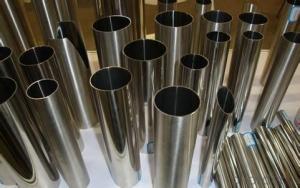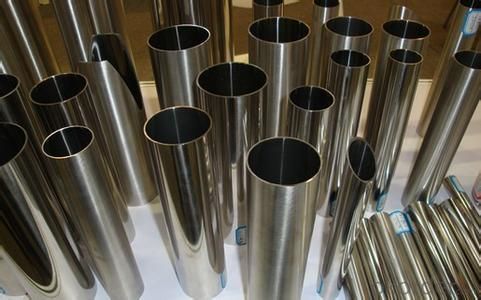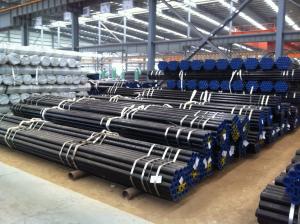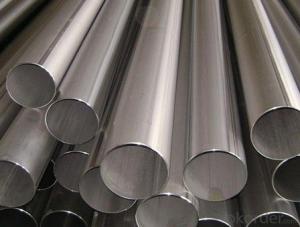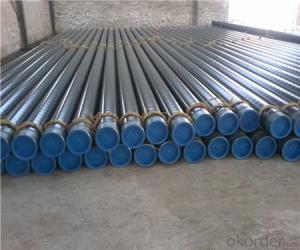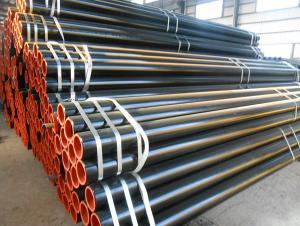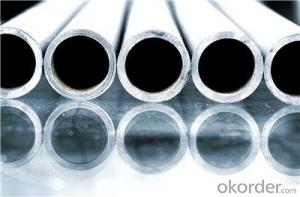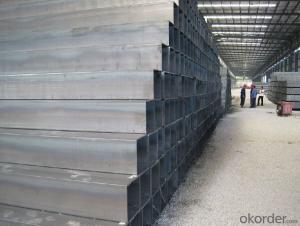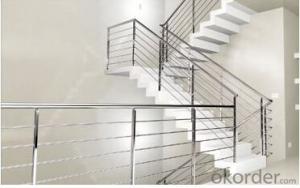ASME API 5L High Quality Stainless Steel Pipe
- Loading Port:
- Tianjin
- Payment Terms:
- TT or LC
- Min Order Qty:
- 25 m.t.
- Supply Capability:
- 10000 m.t./month
OKorder Service Pledge
OKorder Financial Service
You Might Also Like
We are company that have many years experience and professional manager team and engineer team and sales team, sure we will provide you high quality of pipe and professioanl service.
Seamless pipe possesses a hollow section and without seam around the strip steel. It is made with solid bar or steel ingot by perforating machine. As the facture process does not include any welding, seamless pipes are considered to be stronger and more durable. Generally speaking, seamless pipe has better pressure resistance and security than other classifications, and was usually more easily available than welded pipe.
2、Main Features of the Seamless Pipe:
• High working accuracy
• High strength
• Small inertia resistance
• Strong therming dissipine ability
• Good appearance
• Reasonble price
3、Seamless Pipe Specification:
Standard | GB, DIN, ASTM ASTM A106-2006, ASTM A53-2007 |
Grade | 10#-45#, 16Mn 10#, 20#, 45#, 16Mn |
Thickness | 8 - 33 mm |
Section Shape | Round |
Outer Diameter | 133 - 219 mm |
Place of Origin | Shandong, China (Mainland) |
Secondary Or Not | Non-secondary |
Application | Hydraulic Pipe |
Technique | Cold Drawn |
Certification | API |
Surface Treatment | factory state or painted black |
Special Pipe | API Pipe |
Alloy Or Not | Non-alloy |
Length | 5-12M |
Outer Diameter | 21.3-610mm |
Grade | 20#, 45#, Q345, API J55, API K55, API L80, API N80, API P110, A53B |
Standard | ASME, ASTM |
1) Material:20#(ASTM A 106/A53 GRB.API5LGRB,GB),45#,16Mn,10#.
2) Specification range: OD: 21.3-610mm, WT:6-70mm, length:6-12m or according to the requirement of clients.
3) Executive standards: GB, ASME API5L.ASTM A 106/A53,Despite of the above standards, we can also supply seamless steel pipe with standard of DIN, JIS, and so on, and also develop new products according to the requirements of our clients!
4) Surface: black lacquered, varnish coating or galvanized.
5) Ends: Beveled or square cut, plastic capped, painted.
6) Packing: bundles wrapped with strong steel strip, seaworthy packing.
4、Packaging & Delivery:
Packaging Details: | seaworthy package, bundles wrapped with strong steel strip |
Delivery Detail: | 15-30days after received 30%TT |
5、FAQ of Seamless Pipe:
①How is the quality of your products?
We have many years business experience in this area, and we have professional engineer and manager team and sure we can provide you high quality production and professional service.
②How about price?
Yes, we are factory and be able to give you lowest price below market one, and we have a policy that “ for saving time and absolutely honest business attitude, we quote as lowest as possible for any customer, and discount can be given according to quantity”,if you like bargain and factory price is not low enough as you think, just don’t waste your time.Please trust the quotation we would give you, it is professional one.
③Why should you chose us?
We can give you both.Additionally, we can also offer professional products inquiry, products knowledge train(for agents), smooth goods delivery, exellent customer solution proposals.Our service formula: good quality+good price+good service=customer’s trust
SGS test is available, customer inspection before shipping is welcome, third party inspection is no problem.
6、Seamless Pipe Images:
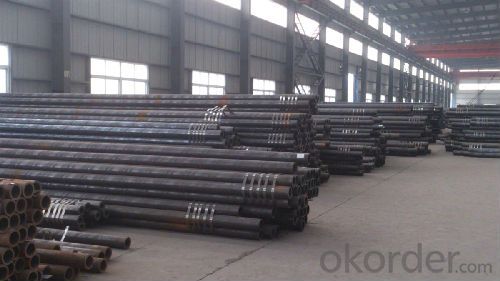
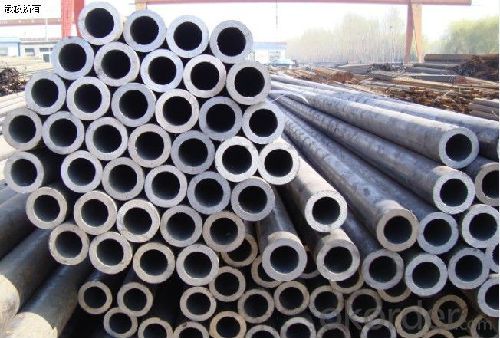
- Q: What is the difference between Schedule and Nominal Pipe Sizes for stainless steel pipes?
- The difference between Schedule and Nominal Pipe Sizes for stainless steel pipes lies in their respective measurements. Schedule refers to the wall thickness of the pipe, while Nominal Pipe Size (NPS) indicates the approximate inside diameter of the pipe. The Schedule system is based on a standard thickness range, denoted by a specific number, such as Schedule 40 or Schedule 80, which are commonly used in industrial applications. On the other hand, NPS provides a standardized label for pipes that corresponds to a specific inside diameter, regardless of the wall thickness. Therefore, while Schedule determines the strength and pressure rating of a stainless steel pipe, NPS primarily denotes its size for compatibility with fittings and other components.
- Q: Can stainless steel pipes be insulated with polypropylene?
- Indeed, polypropylene serves as an appropriate material for insulating stainless steel pipes. This is due to its remarkable thermal properties and minimal thermal conductivity. Polypropylene exhibits resistance against moisture, chemicals, and UV radiation, rendering it suitable for diverse applications. By implementing polypropylene insulation, the loss or gain of heat in stainless steel pipes can be averted, thereby enhancing energy efficiency and decreasing the likelihood of condensation or freezing. Consequently, it is imperative to guarantee the correct installation and compatibility of the polypropylene insulation with the particular stainless steel pipe in order to attain optimal performance and durability.
- Q: Mirror stainless steel tube 60*60 how much is one meter?
- Single weight multiplied by unit price.Weight calculation formula of single round stainless steel tube: (outside diameter actual thickness) * actual thickness *0.02491* length,
- Q: What is the difference between 321 and 321H stainless steel pipes?
- The main difference between 321 and 321H stainless steel pipes lies in their carbon content and resulting mechanical properties. Both grades are stabilized austenitic stainless steels with titanium as the stabilizing element. However, 321H contains a higher carbon content compared to 321. The increased carbon content in 321H provides improved high-temperature strength and creep resistance. This makes 321H suitable for applications where elevated temperatures are involved, such as in the manufacturing of heat exchangers, furnace parts, and other high-temperature equipment. On the other hand, 321 stainless steel pipes are commonly used in applications that do not require exposure to high temperatures. They offer excellent resistance to intergranular corrosion and are frequently used in the aerospace industry, as well as for the fabrication of exhaust systems, chemical processing equipment, and other general-purpose applications. In summary, the difference between 321 and 321H stainless steel pipes lies in their carbon content and resulting mechanical properties. 321H is specifically designed for high-temperature applications, while 321 is suitable for general-purpose applications that do not require exposure to elevated temperatures.
- Q: How do you calculate the required support spacing for stainless steel pipes?
- To calculate the required support spacing for stainless steel pipes, you need to consider factors such as the pipe material, size, weight, temperature, and the support system used. The most common method is to refer to industry standards and guidelines, such as the American Society of Mechanical Engineers (ASME) B31.1 or B31.3 codes, which provide formulas and charts to determine the appropriate support spacing based on these factors. Additionally, consulting with a structural engineer or piping specialist is recommended to ensure accurate calculations and comply with safety regulations.
- Q: What is the difference between seamless and welded stainless steel pipes?
- The main difference between seamless and welded stainless steel pipes lies in their manufacturing process and the resulting characteristics of the pipes. Seamless stainless steel pipes are produced by piercing a solid billet or ingot, heating it to a high temperature, and then rolling it into a hollow cylindrical shape. This process ensures that there are no seams or joints in the pipe, resulting in a smooth and uniform surface. Seamless pipes are generally considered to have higher strength and better corrosion resistance compared to welded pipes. They are also preferred in applications where high pressure or temperature is involved, as their seamless nature makes them more reliable and less prone to leaks. On the other hand, welded stainless steel pipes are manufactured by joining two or more pieces of steel together using various welding techniques. This process introduces a seam or weld line along the length of the pipe. Welded pipes can be produced in a continuous or intermittent welding process, depending on the required specifications. While welded pipes may have slightly lower strength and corrosion resistance compared to seamless pipes, advancements in welding technology have significantly improved their quality and performance. Welded pipes are generally more cost-effective and commonly used in applications where lower pressure or temperature is involved. In summary, the difference between seamless and welded stainless steel pipes lies in their manufacturing process and resulting characteristics. Seamless pipes, with no seams or joints, offer higher strength, better corrosion resistance, and are preferred in high-pressure or temperature applications. Welded pipes, with welded seams, are more cost-effective, commonly used in lower-pressure or temperature applications, and have seen significant improvements in quality and performance. Ultimately, the choice between seamless and welded pipes depends on the specific requirements of the application and cost considerations.
- Q: Can stainless steel pipes be insulated with polystyrene sulfonate?
- Yes, stainless steel pipes can be insulated with polystyrene sulfonate. Polystyrene sulfonate is a type of insulation material that is commonly used for its excellent thermal and moisture resistance properties. It can be applied to stainless steel pipes to reduce heat loss or gain and prevent condensation. This insulation material can provide effective insulation in a wide range of temperatures and is often chosen for its durability and long-lasting performance. However, it is important to ensure that the polystyrene sulfonate insulation is compatible with the specific application and meets the necessary safety and regulatory requirements.
- Q: What is the composition of stainless steel pipes?
- Stainless steel pipes are primarily composed of iron, chromium, and varying amounts of other elements such as nickel, manganese, and molybdenum.
- Q: Are stainless steel pipes suitable for paper mills?
- Yes, stainless steel pipes are suitable for paper mills. Stainless steel is known for its excellent corrosion resistance, making it ideal for use in environments where there is exposure to moisture, chemicals, and high temperatures. In paper mills, where there is a constant presence of water and chemicals used in the paper-making process, stainless steel pipes offer durability and longevity. They are resistant to rust and corrosion, ensuring that the pipes will not degrade over time, which can lead to leaks or contamination of the paper production. Furthermore, stainless steel pipes are also easy to clean and maintain, which is crucial in paper mills where cleanliness and hygiene are of utmost importance to ensure the quality of the paper products. The smooth surface of stainless steel pipes prevents the buildup of debris, reducing the risk of blockages and improving the flow of materials. Additionally, stainless steel pipes have high strength and can withstand high temperatures, making them suitable for the extreme conditions found in paper mills. They can handle the hot water, steam, and chemicals used in various stages of the paper-making process without deteriorating or losing their structural integrity. Overall, the excellent corrosion resistance, cleanliness, durability, and high-temperature resistance of stainless steel pipes make them highly suitable for use in paper mills, contributing to efficient and reliable paper production processes.
- Q: How do you calculate the maximum allowable deflection for stainless steel pipes?
- To calculate the maximum allowable deflection for stainless steel pipes, you need to consider several factors. Firstly, you should determine the material properties of the stainless steel being used, such as its modulus of elasticity (E) and yield strength (σy). These properties can usually be obtained from material specifications or testing. Next, you need to determine the allowable stress (σa) for the stainless steel pipe. This value is typically a fraction of the yield strength, usually around 0.4 or 0.5 times the yield strength, to ensure the safety and integrity of the pipe. Once you have these values, you can use the formula for deflection in a simply supported beam to calculate the maximum allowable deflection. This formula is: δ = (5 * w * L^4) / (384 * E * I) Where: δ = maximum deflection w = load per unit length applied to the pipe L = length of the pipe E = modulus of elasticity of the stainless steel I = moment of inertia of the cross-section of the pipe In this case, the load per unit length (w) can be calculated based on the weight of the material being transported or the external forces acting on the pipe. The moment of inertia (I) depends on the cross-sectional shape of the pipe. For example, for a circular pipe, the moment of inertia (I) is (π * D^4) / 64, where D is the diameter of the pipe. By plugging in the known values into the formula, you can calculate the maximum allowable deflection for the stainless steel pipe. It is important to ensure that the calculated deflection is within the maximum allowable limit to maintain the structural integrity and functionality of the pipe.
Send your message to us
ASME API 5L High Quality Stainless Steel Pipe
- Loading Port:
- Tianjin
- Payment Terms:
- TT or LC
- Min Order Qty:
- 25 m.t.
- Supply Capability:
- 10000 m.t./month
OKorder Service Pledge
OKorder Financial Service
Similar products
Hot products
Hot Searches
Related keywords
